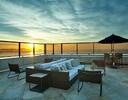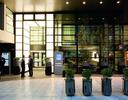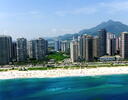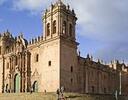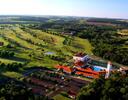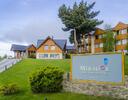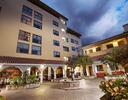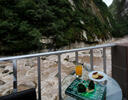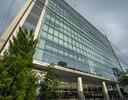Best of South America ... Argentina, Brazil, Peru
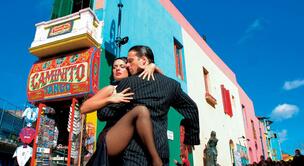
Best of South America
Andean peaks, Amazonian rainforest, Patagonian glaciers, Incan ruins, colonial towns, white-sand beaches and vertiginous nightlife: the wonders of South America set the stage for incredible adventures.
Setting for Big Adventures - You can hike past ancient temples first laid down by the Incas, contemplate the awe-inspiring power of Iguazú Falls, or spend the day watching wildlife from a dugout canoe on one of the Amazon's countless igarapés (narrow waterways). You can barrel down Andean roads by mountain bike, go white-water rafting on Class V rivers and surf amazing breaks off both coasts. And once you think you've experienced it all, head to the dramatic landscapes in Tierra del Fuego, go eye-to-eye with extraordinary creatures in the Galápagos, and scramble up tableland mountains in the Gran Sabana for a panorama that seems straight out of the Mesozoic era.
Cultural Treasures - South America's diversity doesn't end with landscapes. You'll find colonial towns where cobblestone streets lead past gilded churches and stately plazas little changed since the 18th century. You can haggle over colorful textiles at indigenous markets, share meals with traditional dwellers of the rainforest and follow the pounding rhythms of Afro-Brazilian drum corps. South America is home to an astounding variety of living and ancient cultures, and experiencing it first-hand is as easy as showing up.
La Vida Musical - This is one of the world's great music destinations. Nothing compares to hearing the rhythms of Colombian salsa, Brazilian samba, Argentine tango and Andean folk music in the place where they were born. Buenos Aires' sultry milongas (tango clubs), Rio's simmering garrafeiras (dance halls), Quito's salsotecas (salsa clubs) – all great places to chase the heart of Saturday night. Yet this is only the beginning of a great musical odyssey that encompasses Peruvian trovas, soulful Ecuadorian passillos, fast-stepping Brazilian forró, whirling Venezuelan merengue, steel-pan Guyanese drumming, Paraguayan harp music and more. Simply plunge in – though you might want to take a dance class along the way!
Captivating Landscapes - From the snow-capped peaks of the Andes to the undulating waterways of the Amazon, South America spreads a dazzling array of natural wonders. This is a continent of lush rainforests, towering volcanoes, misty cloud forests, bone-dry deserts, red-rock canyons and ice-blue glaciers. After taking in some of the incredible natural wonders found in every country in South America, you can head to the coast for an idyllic retreat among palm-fringed, white-sand beaches and photogenic tropical islands. As landscapes go, there aren't many other places on earth that offer so much variety.
Why I love South America [By Regis St Louis, Writer] - Be mindful of what you're getting into: South America can be a lifetime addiction. I didn't realize this when I first hiked Andean trails and visited pre-Colombian sites more than 15 years ago. Like other travelers who shared the journey, I was hooked. I fell hard for the incredible wonders of this continent: its mist-covered peaks, thundering falls and vast rainforests. Add to this the human-made treasures: buzzing indigenous markets, picturesque colonial towns and vibrant cityscapes. This is just the beginning, and in South America there really is no end. It's the reason I've returned so many times, but know there is still much more to discover.
Itinerary
- Day 1
Arrival Rio De Janeiro / Half day city tour
Upon arrival at Rio De Janeiro airport, meet & greet by our representative, transfer to hotel for check in
Golden beaches and lush mountains, samba-fueled nightlife and spectacular football matches: welcome to the Cidade Maravilhosa (Marvelous City).
Looking out from the 710m peak of Corcovado, you will see why Rio is called the Cidade Maravilhosa. Lushly forested mountains fringe the city, shimmering beaches trace the shoreline and a string of tiny islands lie scattered along the seafront. Far from being mere cinematic backdrop, this seaside beauty hosts outstanding outdoor adventures: hiking in the Tijuca rainforest, cycling alongside the lake and beaches, sailing across Baía de Guanabara (Guanabara Bay), and surfing, rock climbing and hang gliding amid one of the world's most stunning urban landscapes.
Rio's beaches have long seduced visitors. Copacabana Beach became a symbol of Rio during the 1940s, when international starlets would jet in for the weekend. Hogging the spotlight these days is Ipanema Beach, its fame and beauty unabated since bossa nova stars Tom Jobim and Vinícius de Moraes introduced the world to its allure in the 1960s.
For cariocas (residents of Rio), the beach is Rio's backyard – a playground that's free and open to all, offering endless enjoyment in the form of football, volleyball, surfing, snacking, drinking or simply relaxing amid the passing parade of people.
Music is Rio's lifeblood, and the city's soundtrack comprises rock, old-school bossa nova, hip-hop, funk and Brazil's many regional styles. Above all there's samba, a rapid-fire style of music with African influences and an infectious beat that is synonymous with Rio. You can hear it all over town, but the soul of samba resides in Lapa, an edgy red-light district that's home to dozens of live-music halls and an enormous weekend street party that draws revelers from all walks of life.
Speaking of Carnaval, Rio knows how to party. Whether you call it joie de vivre, Lebensfreude or lust for life, cariocas have it in spades. Carnaval, and the buildup to it, is the most obvious manifestation of this celebratory spirit. But Rio has many other occasions for revelry: celebrations after a big Flamengo (or Vasco, Fluminense or Botafogo) soccer match; weekend samba parties around town; baile funk parties in the favelas (slums, informal communities); and boat parties on the bay – not to mention major fests such as Réveillon (New Year's Eve) and the Festas Juninas.
After check in and some rest, half day city tour of Rio assisted by our bilingual guide
After the demolition of the Perimetral elevated highway (replaced by expressways, tunnels and a new boulevard), downtown of Rio de Janeiro was completely revitalized, becoming a center of cultural and gastronomic activities for local people and tourists.
The construction of Orla Conde, the city’s new shore (3.5 km long promenade) outlining the Guanabara Bay, rescued the area allowing people to enjoy a place that that was previously restricted to the Marine officers. Open for pedestrians and cyclists, it’s an invitation for relaxing and contemplating that gives the visitors the opportunity of seeing the city from a new angle. We believe that the revitalization of this area is one of the most important legacies of the Olympic Games to our city. This is the new Port Zone, the so-called “Porto Maravilha”.
Dinner at Indian restaurant
Overnight at Rio De Janeiro - Day 2
Rio De Janeiro / Visit Sugar Loaf Mountain
After breakfast, day trip visiting Guanabara Bay and Sugar Loaf Mountain
Depart in a private a/c vehicle with a bilingual guide assistance for a schooner cruise, embarking from the Marina da Gloria Pier.
Route follows along the coastline of Rio de Janeiro, passing by Flamengo, Botafogo and Urca beaches, with a view of Sugar Loaf Mountain. Proceeding as far as Niterói´s beaches, where you can admire the beaches of Jurujuba, Charitas and Icaraí. Among other attractions, tour also includes views of Fiscal Island, Rio-Niterói bridge and historic fortresses. Return to Marina da Glória Píer.
You will head downtown and have the opportunity to get to know the old Rio with its paving stones and breathtaking architecture; you will get to see Candelaria Church, Rio’s Aqueduct, Municipal Theater, the National Library, among other attractions.
Afterwards you will be led to Sugar Loaf, the famous mountain, reached by cable car 1,200 feet high, offering you an unforgettable view of the city.
Lunch at Terra Brasilis restaurant
Sugar Loaf Mountain - The Sugar Loaf Mountain is one of the most important natural, historical and touristic landmark of the city of Rio de Janeiro. With its unusual warhead shape, the Sugarloaf Mountain (in Portuguese, Pão de Açúcar) is a monolithic mountain of granite and quartz that rises at the mouth of Guanabara Bay. Its name is said to refer to its resemblance to the traditional shape of concentrated refined loaf sugar.
Dinner at Indian restaurant
Overnight at Rio De Janeiro - Day 3
Rio De Janeiro / Half day Tour Corcovado and beaches
After breakfast, depart for Cosmo Velho station where you will board a cog-wheel train for the ride through Tijuca Forest, and up Corcovado Mountain (748 meters high).
The train ride takes 20 minutes and is a wonderful opportunity to have a closer look at the forest's lush tropical vegetation and enjoy scenic landscapes of the city and its beaches. Disembarking at the top of Corcovado and proceeding up the steps (or elevator and escalators) that lead to the top lookout where the towering statue of Christ the Redeemer stands.
Corcovado Mountain
Corcovado Mountain towers over the vibrant Brazilian city of Rio de Janeiro. Originally, the mountain was called Pinaculo da Tentacao, which translates to ‘Pinnacle of Temptation’. This has Biblical references and was chosen by the Portuguese settlers of centuries ago. Later, it was renamed Corcovado, which refers to its ‘hunchback’ shape.
The Corcovado Mountain is situated within the Tijuca Forest National Park, enjoying a degree of protection. It is 2 300 feet (or just over 700 metres) high.
However, this mountain is notable, not only for its natural beauty and prime positioning, but also because it is the foothold of the globally recognised statue called Christ The Redeemer. This statue is 100 feet (or 30 metres) high and depicts Jesus Christ standing over the city of Rio de Janeiro with his arms outstretched.
After appreciating the breathtaking view unfolding below, you will descend by train and continue tour passing by some of Rio's beaches. During the tour, lunch at local restaurant
Later head back to the hotel
Evening at leisure
Dinner at Indian restaurant
Overnight at Rio De Janeiro - Day 4
Flight from Rio De Janeiro to Iguassu Falls / Sightseeing of Iguassu Falls from Brazilian side
After breakfast, transfer in exclusive vehicle to the airport for flight to Iguassu Falls
One of the planet’s most awe-inspiring sights, the Iguazú Falls are simply astounding. A visit is a jaw-dropping, visceral experience, and the power and noise of the cascades – a chain of hundreds of waterfalls nearly 3km in extension – live forever in the memory. An added benefit is the setting: the falls lie split between Brazil and Argentina in a large expanse of national park, much of it rainforest teeming with unique flora and fauna.
The falls are easily reached from either side of the Argentine–Brazilian border, as well as from nearby Paraguay.
Upon arrival at Iguassu Falls, meet & greet by our representative, transfer in exclusive vehicle to hotel on Brazilian side
Later depart for Iguassu falls tour from Brazilian side
Depart from your hotel and cross Iguassu National Park to the Brazilian side of the Falls. Walk along the long paths that follow the cascades to the catwalk that leads close to the bottom of Devil's Throat where you will enjoy magnificent views.
Take an elevator up to the road and return to the hotel.
Dinner & Overnight at Iguassu Falls Hotel - Day 5
Iguassu Falls / Sightseeing of Iguassu Falls from Argentinian side
After breakfast, depart from the Hotel, with a stop for quick customs check, you will cross the Tancredo Neves bridge over the Iguaçu River, which forms the border between Argentina and Brazil.
Iguassu Falls from Argentina Side
On this side of the falls, you’re much more likely to get wet than you are on the Brazilian side because the walkways take you literally within arm's length of some of the falls. As you walk along, you find yourself beside the crest of one cascade, then as the walkways gradually descend, at the bottom of another. Wear waterproof clothing and bring protection for your camera, as it can get quite wet out there.
Once in Argentina, the tour takes a scenic highway up the Argentinian Iguazu National Park. Tour starts with ample time to visit the Argentinian falls. Stopping at the Visitors Center and proceeding from there to the Superior Circuit (up-river cascades), to the Inferior Circuit (down-river falls). Then take the Ecological Jungle Train to the most impressive observation point of the falls - The Devil´s Throat.
The Ecological Jungle Train - This newest additions to a tour in Iguazu Falls, the Ecological Jungle Train, is a quiet, natural gas powered train that leaves from the central station (near the park entrance) and ends close to the Devil’s Throat. Its14 kilometer, 25 minute journey heads into unseen parts of the park. Its quiet, open plan allows those riding to see as well as hear the jungle forest, taking in all that comes with being in the jungle (the smells, sounds, feeling of the humid air and dense vegetation) without having to leave the train’s comfort.
The train is the only way to progress to this important highlight of the Iguazu Falls National Park, and serves as a good suspense builder as it putters silently through the jungle. At night, during a full moon tour, this effect is doubly magnified.
In the evening back to Brazilian side of Iguassu Falls
Dinner & Overnight at Iguassu Falls Hotel - Day 6
Flight from Foz Do Iguassu to Buenos Aires / Tango Dance Show
After Brazilian buffet breakfast, transfer by exclusive vehicle to airport for flight to Buenos Aires
Buenos Aires combines faded European grandeur with Latin passion. Sexy and alive, this beautiful city gets under your skin.
Steak, Wine & Ice Cream - BA's food scene is increasingly dynamic, but for many travelers it's the city's carnivorous pleasures that shine. Satisfying a craving for juicy steaks isn't hard to do in the land that has perfected grilling wonderfully flavorful sides of beef, washed down with a generous glass of malbec or bonarda. Parrillas (steakhouses) sit on practically every corner and will offer up myriad cuts, from bife de chorizo (sirloin) to vacio (flank steak) to ojo de bife (rib eye). But leave room for ice cream, if you can – a late-night cone of dulce de leche (caramel) helado can't be topped.
Art & Architecture - Look closely: this city is beautiful. Sure, it might look like a concrete jungle from certain angles, but stroll through the streets, paying attention to the magnificent architecture around you, and you'll soon be won over. Grand French- and Italian-style palaces grab the limelight, but you'll see interesting architectural details in the buildings of even low-key, local barrios.
Nightlife - Take a disco nap, down some coffee and be prepared to stay up all night – this city doesn't sleep. Restaurants get going at 9pm, bars at midnight and clubs at 2am at the earliest; serious clubbers don't show up until 4am. And it's not just the young folk who head out on the town in this city; BA's diverse range of bars, clubs and live-music venues offers something for everyone, from DJs spinning electronica to live jazz sets. Just remember you'll be doing it all very late.
Tango - BA's famous dance is possibly the city's greatest contribution to the outside world, a steamy strut that's been described as 'making love in the vertical position'. Folklore says it began in the bordellos of long-ago Buenos Aires, when men waiting for their 'ladies' passed time by dancing among themselves. Today, glamorized tango shows are supremely entertaining with their grand feats of athleticism. You'll also find endless venues for perfecting your moves, from milongas (dance salons) to dance schools. Be aware that some people become addicted – and can spend a lifetime perfecting this sensual dance.
Upon arrival, you will be welcomed by our representative at the international airport and transferred to your hotel.
Later in the evening transfer to tango house to enjoy dinner and show. Enjoy a show with music, singing and dancing. The dinner includes entrée, main course, dessert & drinks.
Tango Dance Show : The Tango tradition started at the end of the 19th century, and developed out of a mixture of various rhythms, which were originally danced in the poorer neighborhoods. Tango is reflecting the nostalgia and melancholy of the European immigrants and brought up some great musicians, such as Astor Piazzolla and Anibal Troilo.
Tango Porteño recovers and crystallizes the Tango essence in a unique place, a formerly movie theatre building that used to belong to the Metro Goldwyn Meyer Company. This venue combines the most refined atmosphere with the typical deco style of the golden days, great artists, unbeatable productions and first-class cuisine.
Overnight at Buenos Aires - Day 7
Flight from Buenos Aires to El Calafate
After breakfast, transfer to airport and fly to El Calafate
Named for the berry that, once eaten, guarantees your return to Patagonia, El Calafate hooks you with another irresistible attraction: Glaciar Perito Moreno, 80km away in Parque Nacional Los Glaciares.
This magnificent must-see has converted once-quaint El Calafate into a chic fur-trimmed destination. With a range of traveler services, it’s still a fun place to be. Its strategic location between El Chaltén and Torres del Paine (Chile) makes it an inevitable stop for those in transit.
El Calafate flanks the southern shore of Lago Argentino. Its main strip is dotted with souvenir and chocolate shops, restaurants and tour offices. Beyond here, pretensions melt away quickly: muddy roads lead to ad hoc developments and open pastures.
January and February are the most popular (and costly) months to visit, but shoulder-season visits are growing steadily.
Upon arrival, you will be welcomed at the airport and taken to your hotel
Rest of the day at leisure
Dinner & Overnight at El Calafate hotel - Day 8
El Calafate / Perito Moreno Glacier & Los Glaciares National Park
After breakfast depart for Perito Moreno Glacier tour
Perito Moreno Glacier tour
A must for all visitors to Argentina is a visit to Glacier Perito Moreno at Los Glaciares National Park. It forms part of the Patagonian Continental Ice Field from which 13 glaciers descend on the Atlantic side to flow into the Viedma and Argentino lakes.
The Perito Moreno glacier is 5km (3.12mi.) wide and 60m (197ft.) high above Argentino Lake, is one of the few in the world which still advances forming a wall and containing the Brazo Rico waters. Every 4 or 5 years, the water pressure is so strong that it breaks into multiple pieces giving an overwhelming spectacle that is truly impossible to explain.
The continuous slides from its frozen walls astonish you at any time throughout the year. Los Glaciares National Park entrance is located at 80km (50mi.) away from El Calafate town.
Today you will get impressed during this tour where you will be able to admire breathtaking glacier views via walking tours through the catwalks.
Safari Nautico Navigation Tour
This navigation completes the excursion to the Perito Moreno Glacier. Embarking at Bajo Las Sombras, 7 km away from the Moreno glacier balconies, this excursion takes you on a cruise across Lake Rico (southern arm of Lake Argentino), passing beside icebergs which have calved off the front of the Perito Moreno glacier all along the south wall of this glacier.
Reaching the Icebergs Channel, the boat will stop at a safe distance from the glacier, continuing to sail down all its front, allowing a spectacular view of the high wall of ice.
The excursion lasts approximately one hour and provides a totally different perspective of the Perito Moreno glacier, with almost constant falling walls of ice from its front. Unique opportunity for photographers and nature lovers alike.
Lunch at Nativos restaurant during the tour [without beverages]
Transfer back to Hotel by evening
Dinner & Overnight at El Calafate hotel - Day 9
El Calafate to Buenos Aires / City Tour
After breakfast, transfer to airport and fly to Buenos Aires
Proceed with your city tour of Buenos Aires
Starts with visit to famous 9 de Julio Avenue, which is known as the widest avenue of the world. Pass by the beautiful Colon Theater, the cultural pride of Buenos Aires.
You then arrive at the main square Plaza de Mayo, which is surrounded by the Casa Rosada (Government House), the Metropolitan Cathedral and the Cabildo (first City Hall). Inside visit of the Metropolitan Cathedral.
Continue to San Telmo, a historical neighborhood and the eldest district of Buenos Aires with many antique stores. On Sundays, a visit of San Telmo`s antique fair is a "MUST".
Your next stop is La Boca, a very colorful area of painted houses with the famous street Caminito.
The tour ends with the northern districts. Drive to the green area of Palermo with its parks and artificial lakes.
Then, visit Recoleta area which offers lots of elegant boutiques and restaurants.
At the cemetery of Recoleta you will find the grave of Eva Duarte, known as Evita. The mausoleums and pantheons reflect the architectural diversity emerging from the different cultural tendencies Argentina incorporated in its formation as a nation.
Later dinner at Indian Restaurant
Overnight at Buenos Aires - Day 10
Flight Buenos Aires - Lima - Cuszo
After breakfast, transfer to airport for flight to Cuzco
Welcome to the navel of the world. The undisputed archaeological capital of the Americas, Cuzco is the continent’s oldest continuously inhabited city and the gateway to Machu Picchu. Cosmopolitan Cuzco (also Cusco, or Qosq’o in Quechua) thrives with a measure of contradiction. Ornate cathedrals squat over Inca temples, massage hawkers ply the narrow cobblestone passages, a rural Andean woman feeds bottled water to her pet llama while the finest boutiques sell pricey alpaca knits.
Visitors to the Inca capital get a glimpse of the richest heritage of any South American city. Married to 21st-century hustle, Cuzco can be a bit disconcerting (note the McDonald's set in Inca stones). Soaring rents on the Plaza de Armas and in trendy San Blas are increasingly pushing locals to the margins. Foreign guests undoubtedly have the run of the roost, so showing respect toward today’s incarnation of this powerhouse culture is imperative.
You will be welcomed by our representative at the airport and driven to your hotel
Day at leisure to explore the streets of Cusco on your own
Later in the evening you will be picked up at given time at the hotel and walk to the restaurant.
Dinner at a local restaurant. After the meal you walk back to your hotel
Overnight at Cuzco - Day 11
Cuzco / City Tour
After breakfast depart for half day City tour & Cusco ruins
Start your Cusco City Tour in the “Plaza de Armas” and visit the impressive renaissance-style Cathedral. Make your way through small alleys edged with Incan walls until you reach Koricancha, the temple dedicated to the sun “Inti”. Believed to be the most important temple for the Incas, it was destroyed by the Spanish conquerors in the 16th century. Its foundations were used to build the Catholic Church Santo Domingo. Continue your journey into the past as you explore the different Inca ruins around Cusco. Your first stop is Sacsayhuamán, the Inca ceremonial fortress dedicated to the sun. Admire the gigantic rocks used to build the site and the way they were perfectly fitted together. Nearby, head to Qenqo, a temple carved in a gigantic monolith with tunnels and chambers that were hand carved by men thousands of years ago. Visit the Puca Pucara fort, an important a military checkpoint for Inca Empire. End your tour at the Inca Baths known as Tambomachay and learn about the aqueducts and channels that allow the water to flow naturally.
Plaza de Armas : In Inca times, the plaza, called Huacaypata or Aucaypata, was the heart of the capital. Today it’s the nerve center of the modern city. Two flags usually fly here – the red-and-white Peruvian flag and the rainbow-colored flag of Tahuantinsuyo. Colonial arcades surround the plaza, which in ancient times was twice as large, also encompassing the area now called the Plaza Regocijo. On the plaza’s northeastern side is the imposing cathedral, fronted by a large flight of stairs and flanked by the churches of Jesús María and El Triunfo. On the southeastern side is the strikingly ornate church of La Compania de Jesus.
Koricancha : Koricancha is the most impressive example of how Inca and Hispanic cultures fused together. The remains of the ancient Peruvians' Sun Temple were used as foundations on which the Santo Domingo church and convent was built. The temple is a symbol of Western dominance. The site is a living example of the co-existence of Peru's past with European architecture.
Sacsayhuamán : Located on the outskirts of the ancient Inca capital of Cuzco. It rests on an artificially levelled mountaintop, and consists of three outer lines of gargantuan walls, 1,500 ft long and 54 ft wide, surrounding a paved area containing a circular stone structure believed to be a solar calendar. The ruins also include a 500,000 gallon water reservoir, storage cisterns, ramps, citadels and underground chambers.
Qenqo : Qenqo is a unique temple in its construction as well, having been entirely carved out of a gigantic monolith. Stretched across a hillside, the temple is carved out of rock and marries the man-made tunnels with natural chambers. One of these chambers features 19 small niches and is set up as an amphitheater.
The Puca Pucara fort : This construction is located 6km from Cusco. "Puca" in Quechua means "Red" and "Pucara" means "Fortress-Watchtower. Located at a strategic point along the road to the Antisuyo (the jungle part of the Inca empire), it also served as a checkpoint on the Inca road and was a military and administrative center.The name means Red Fort, on the red color because the color of the earth. In Puca Pucara there are places, inner plazas, baths, aqueducts, and an old road. The buildings are made of stones that come in many sizes medium-small, on the surface of the rocks is very irregular, compared with other archaeological remains. The urban layout is adequate and functional.
Tambomachay : The Inca baths. This name comes from the Quechua words Tampu, which means place or storage, and Machay, which means rest, is a splendid place where took place a ceremony for the water, and thank for his precious gifts like make the flowers grow, and giving life to all creatures in the universe.
Afternoon, walk up to your restaurant – Kion - for lunch. Later walk back to the hotel.
Dinner & Overnight at Cuzco Hotel - Day 12
Cusco to Aguas Calientes / Machu Picchu
After early breakfast or a packed breakfast, transfer from Hotel to Ollantaytambo train station for train to Aguas Calientes ... 1 hr. 40 mins. ride
For the train ride to/from Machu Picchu /Aguas Calientes only one 5kg piece of hand luggage is allowed. Therefore kindly store all the extra luggage with your Cusco hotel
For the visit of Machu Picchu we recommend good shoes, the trail is without handrail and could be slippery. Walking sticks need to have a rubbery end in order to be permitted inside the Sanctuary. Bags / Backpacks bigger than 40x35x20 as well as umbrellas, Selfie sticks, comestibles and plastics like bags, straws and Styrofoam are not permitted.
Board the train and admire the views of small villages and snow-capped mountains as you travel through the Sacred Valley.
When you reach Aguas Calientes, the small town at the bottom of Machu Picchu, take a shuttle bus up and discover the Inca’s ancient citadel.
Machu Picchu
Shrouded by mist and surrounded by lush vegetation and steep escarpments, the sprawling Inca citadel of Machu Picchu lives up to every expectation. In a spectacular location, it’s the most famous archaeological site on the continent, a must for all visitors to Peru. Like the Mona Lisa or the pyramids, it has been seared into our collective consciousness, though nothing can diminish the thrill of being here. This awe-inspiring ancient city was never revealed to the conquering Spaniards and was virtually forgotten until the early part of the 20th century.
In the most controversial move in Machu Picchu since Hiram Bingham's explorations, the Peruvian authorities changed entries from daily visits to morning and afternoon turns in 2018. Visitors must plan more carefully than ever to seize the experience. Though an expanded limit of 5940 people are now allowed in the complex (including the Inca Trail) daily, demand remains insatiable.
Lunch at Sanctuary lodge local restaurant. Take the shuttle bus back down to Aguas Calientes and walk to your hotel nearby
Evening at leisure
Overnight at Aguas Calientes - Day 13
Aguas Calientes to Machu Picchu / Later train to Cuzco
After early breakfast or packed breakfast, transfer to Machu Picchu ruins by Shuttle bus, thereafter hiking for Huayna Picchu
Deepen your experience of Machu Picchu by heading to the citadel a second time. We recommend taking the first shuttle up to the ruins (5:30am) to avoid the crowds.
You will also visit Huayna Picchu, the small mountain next to Machu Picchu. From its peak you have a splendid view and one of the most famous look-outs onto the ruins.
Huayna Picchu
Huayna Picchu, The Young mountain, this particular mountain is one of the several rock formations which are one of the destinations when the tourist arrives to the Machu Picchu Sanctuary.
It is famous for being the background of many of the pictures took by the tourist, is also have many archeological ruins of very importance for the studies of the zone. According to many studies, the top of the mountain were the seat of the virgins (Acllas) and the superior priest, and every day they worshiped His principal Deity: The sun
You also have the possibility to visit the lesser known moon temple built into a natural cave.
Moon Temple
The famous temple of the moon, which is built and carved from the stone that lies there, their shapes are geometrical. Many Historians and archeologist said that his functions are unknown, but it must be a place where the elite gathered to celebrate some rituals and ceremonies.
After your visit, take the shuttle bus back down to Aguas Calientes, the train through the Sacred Valley, and your transfer back to hotel in Cuzco
Evening at leisure
Dinner & Overnight at Cuzco Hotel - Day 14
Cusco to Lima
After breakfast, transfer to airport for flight to Lima
After Cairo, this sprawling metropolis is the second-driest world capital, rising above a long coastline of crumbling cliffs. To enjoy it, climb on the wave of chaos that spans high-rise condos built alongside pre-Columbian temples and fast Pacific breakers rolling toward noisy traffic snarl-ups. Think one part southern Cali doused with a heavy dose of America Latina.
But Lima is also sophisticated, with a civilization that dates back millennia. Stately museums display sublime pottery; galleries debut edgy art; solemn religious processions recall the 18th century and crowded nightclubs dispense tropical beats. No visitor can miss the capital’s culinary genius, part of a gastronomic revolution more than 400 years in the making.
This is Lima. Shrouded in history (and sometimes fog), gloriously messy and full of aesthetic delights. Don’t even think of missing it.
You will be welcomed by our representative at the airport and driven to your hotel in Lima.
Day at leisure to explore the streets of Lima on your own
Dinner & overnight at Lima hotel - Day 15
Lima / City Tour
After breakfast, depart for Colonial & Contemporary half day City Tour with San Francisco Monastery and Larco Museum
Half Day City Tour
In the historical center, admire the colorful colonial architecture around the “Plaza San Martín” and the main square “Plaza de Armas”, where you can also see the Government Palace, the Cathedral, and the Municipality.
Plaza San Martín : Built in the early 20th century, Plaza San Martín has come to life in recent years as the city has set about restoring its park and giving the surrounding beaux-arts architecture a much-needed scrubbing. It is especially lovely in the evenings, when it is illuminated. The plaza is named for the liberator of Peru, José de San Martín, who sits astride a horse at the center of the plaza.
The Plaza de Armas : also known as the Plaza Mayor, is one of the main tourist attractions in Lima, Peru. From its conception in 1535—the same year in which Francisco Pizarro founded the city of Lima—to the present day, the Plaza de Armas has remained the focal point of the city.
From here, visit the San Francisco Monastery and discover its underground maze of tunnels and catacombs.
San Francisco Monastery : This bright-yellow Franciscan monastery and church is most famous for its bone-lined catacombs (containing an estimated 70,000 remains) and its remarkable library housing 25,000 antique texts, some of which pre-date the conquest.
Finally, head to Lima’s contemporary districts, Miraflores and San Isidro, that combine beautiful parks, such as “El Olivar” and “Parque del Amor”, shopping centers, and modern architecture. End your tour at the Larco Museum and appreciate over 45.000 objects including pre-Columbian ceramics, textiles, gold and silver pieces. Don’t miss the museum’s famous and unique erotic ceramics collection from the Mochica culture.
Larco Museum : In an 18th-century viceroy’s mansion, this museum offers one of the largest, best-presented displays of ceramics in Lima. Founded by pre-Columbian collector Rafael Larco Hoyle in 1926, the collection includes more than 50,000 pots, with ceramic works from the Cupisnique, Chimú, Chancay, Nazca and Inca cultures. Highlights include the sublime Moche portrait vessels, presented in simple, dramatically lit cases, and a Wari weaving in one of the rear galleries that contains 398 threads to the linear inch – a record.
Lunch at the museum's restaurant Café Del Museo
After your meal, you will be brought back to your hotel
Rest of the day at leisure
Dinner and overnight at Lima hotel - Day 16
Lima / Departure
Today, morning at leisure after breakfast
Later check out and transfer to airport to board your onward flight.
Your memorable trip to South America ends here as you return back home !
Notes
Round the year Destination ... Extension recommended to Amazon Forest, Galapagos, Chile and other countries across South America
Hotels
Tour Inclusions [Best of South America]
Accommodation as per itinerary at deluxe & superior hotels
All transfers, sightseeings and excursions by private van
Sightseeings with local English speaking guide at all Destinations
Daily buffet breakfast at hotels
Dinner at restaurants serving Indian & Local cuisine
Notes on itinerary
All our itineraries are "Just for Ideas" ... We will get to know you and customise an itinerary just for you that matches your requirements ... dates of travel, category of hotels, preferred airline, flexibility in choosing sightseeing, mode of travel between cities, etc.
Many of our clients have us design more relaxing, slower paced holidays with more in-depth experiences whereas some simply want to visit various destinations and cover only the highlights.
Together, we will determine the ideal route, pace of travel, accommodations, levels of pampering, style of touring, sightseeing to be included, dining preferences, adventure levels, options to meet locals, dates of travel & much more ! and based on this arrive at a price.
Do feel free to get in touch with us by a quick call on +91 79 29602961 or a short mail on mail@destinations4india.com ... Looking forward




